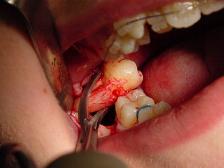Tooth ankylosis
(Redirected from Ankylosis of teeth)
Editor-In-Chief: Prab R Tumpati, MD
Obesity, Sleep & Internal medicine
Founder, WikiMD Wellnesspedia &
W8MD medical weight loss NYC and sleep center NYC
| Tooth ankylosis | |
|---|---|

| |
| Synonyms | Dental ankylosis |
| Pronounce | N/A |
| Specialty | N/A |
| Symptoms | Tooth immobility, infraocclusion |
| Complications | Malocclusion, tooth loss |
| Onset | Childhood or adolescence |
| Duration | Permanent |
| Types | N/A |
| Causes | Trauma, infection, genetic predisposition |
| Risks | Tooth eruption issues, dental caries |
| Diagnosis | Clinical examination, radiographic imaging |
| Differential diagnosis | Tooth impaction, periodontal disease |
| Prevention | Early detection and monitoring |
| Treatment | Surgical intervention, orthodontic treatment |
| Medication | N/A |
| Prognosis | Variable, depending on severity and treatment |
| Frequency | Rare |
| Deaths | N/A |
Tooth Ankylosis is a condition in which a tooth becomes fused to the bone, preventing it from erupting. This can occur in both primary (baby) teeth and permanent (adult) teeth. The condition can lead to a variety of dental problems, including malocclusion (misalignment of the teeth), periodontal disease, and tooth loss.
Causes[edit | edit source]
Tooth ankylosis can be caused by a variety of factors. These include genetic predisposition, trauma to the tooth or jaw, inflammation, and certain systemic diseases. In some cases, the cause of tooth ankylosis is unknown.
Symptoms[edit | edit source]
The most common symptom of tooth ankylosis is a tooth that fails to erupt, or emerges only partially. The tooth may also appear to be shorter than the surrounding teeth. In some cases, the condition may cause no symptoms and may only be detected during a dental examination.
Diagnosis[edit | edit source]
Tooth ankylosis is typically diagnosed through a combination of clinical examination and imaging studies. The dentist may notice that the tooth is not erupting as expected, or that it appears to be shorter than the surrounding teeth. Imaging studies, such as X-rays, can confirm the diagnosis.
Treatment[edit | edit source]
Treatment for tooth ankylosis depends on the severity of the condition and the age of the patient. In some cases, no treatment may be necessary. If the condition is causing problems, such as malocclusion or periodontal disease, treatment options may include orthodontic treatment, extraction of the affected tooth, or surgical intervention.
See also[edit | edit source]
Search WikiMD
Ad.Tired of being Overweight? Try W8MD's physician weight loss program.
Semaglutide (Ozempic / Wegovy and Tirzepatide (Mounjaro / Zepbound) available.
Advertise on WikiMD
|
WikiMD's Wellness Encyclopedia |
| Let Food Be Thy Medicine Medicine Thy Food - Hippocrates |
Translate this page: - East Asian
中文,
日本,
한국어,
South Asian
हिन्दी,
தமிழ்,
తెలుగు,
Urdu,
ಕನ್ನಡ,
Southeast Asian
Indonesian,
Vietnamese,
Thai,
မြန်မာဘာသာ,
বাংলা
European
español,
Deutsch,
français,
Greek,
português do Brasil,
polski,
română,
русский,
Nederlands,
norsk,
svenska,
suomi,
Italian
Middle Eastern & African
عربى,
Turkish,
Persian,
Hebrew,
Afrikaans,
isiZulu,
Kiswahili,
Other
Bulgarian,
Hungarian,
Czech,
Swedish,
മലയാളം,
मराठी,
ਪੰਜਾਬੀ,
ગુજરાતી,
Portuguese,
Ukrainian
Medical Disclaimer: WikiMD is not a substitute for professional medical advice. The information on WikiMD is provided as an information resource only, may be incorrect, outdated or misleading, and is not to be used or relied on for any diagnostic or treatment purposes. Please consult your health care provider before making any healthcare decisions or for guidance about a specific medical condition. WikiMD expressly disclaims responsibility, and shall have no liability, for any damages, loss, injury, or liability whatsoever suffered as a result of your reliance on the information contained in this site. By visiting this site you agree to the foregoing terms and conditions, which may from time to time be changed or supplemented by WikiMD. If you do not agree to the foregoing terms and conditions, you should not enter or use this site. See full disclaimer.
Credits:Most images are courtesy of Wikimedia commons, and templates, categories Wikipedia, licensed under CC BY SA or similar.
Contributors: Prab R. Tumpati, MD



